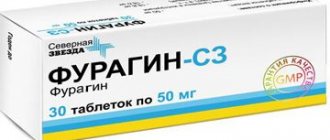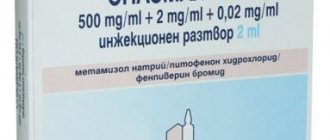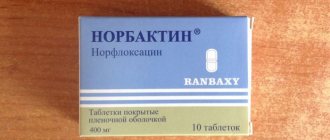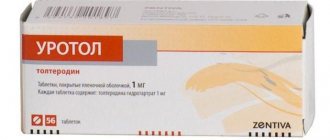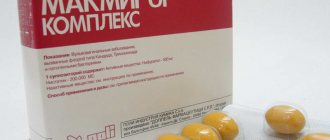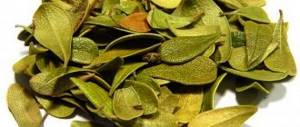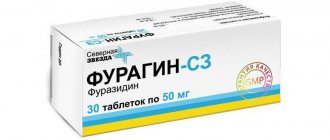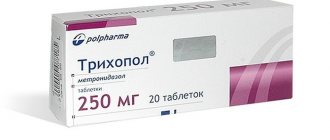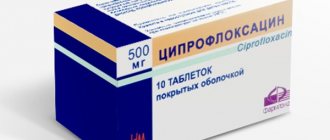pharmachologic effect
Manufacturer: Irbitsky Chemical Plant, Tatkhimfampreparaty, Russia
Release form: film-coated tablets
Active ingredient: Nitroxoline
Synonyms: 5-NOK, Nitroxoline-AKOS
Nitroxoline is a synthetic antimicrobial drug that has a bacteriostatic effect against bacteria such as staphylococci, streptococci, enterococci, Klebsiella, salmonella and many others. Also active against mycobacteria, trichomonas and some types of fungi.
The antimicrobial effect is due to the suppression of bacterial DNA synthesis.
The drug is excreted unchanged by the kidneys, large concentrations are created in the urine, so the drug is prescribed for genitourinary infections.
Patients often ask the question, is Nitroxoline a diuretic?
We can definitely answer that it is not, unlike plant uroseptics (bearberry, lingonberry, juniper), which have a complex effect, including a diuretic.
Nitroxoline - antibiotic or not
Nitroxoline tablets do not belong to the group of antibiotics; they are a separate type of uroseptics - a derivative of 8-hydroxyquinoline.
special instructions
There are some nuances in application.
Before starting treatment with Nitroxoline, you should familiarize yourself with some precautions:
- During medication therapy, the urine may become saffron yellow.
- The medicine contains sucrose, which should be taken into account when taken by people diagnosed with diabetes.
- People with concomitant lactose intolerance, lactase deficiency or glucose-galactose malabsorption should take the tablets with caution.
- There is no information about the negative effect of the drug on brain function, psychomotor speed and concentration.
- The medicine can interact with medications belonging to other pharmacological groups, and therefore, if other medications are taken, you should notify the doctor about this.
Nitroxoline - instructions for use
An adult should take the medicine 2-4 tablets 3-4 times a day for 2-3 weeks.
For a child over 5 years old – 1–2 tablets. Up to 5 years of age, the pediatric dose is calculated depending on body weight - 10–30 mg per 1 kg of body weight per day, divided into 3–4 doses, taking into account that 1 tablet contains 50 mg of the drug.
Taking Nitroxoline before or after meals does not matter.
Before use, you must carefully read the instructions for use of Nitroxoline for possible contraindications.
Overdose
Each patient's body responds differently to the substances that enter it. Liver functions and the ability to eliminate medications also differ in patients.
In some cases, during treatment with a standard dosage of the drug for a long time, at the end of the course of therapy, a person may experience symptoms of intoxication.
If the dose is exceeded, the following symptoms may develop:
- cardiopalmus,
- prolonged vomiting,
- allergic skin rashes,
- headache.
To get rid of the signs of poisoning, you must stop taking Nitroxoline, and also consult a doctor to prescribe symptomatic treatment. In this case, an analgesic, cardiac, or antiemetic (for example, Truxal) medication may be prescribed.
Nitroxoline analogs
Nitroxoline can be replaced with other antimicrobial drugs from the group of uroseptics that are active against the same microorganisms. All analogues can be divided into groups:
- Antibiotics (Flemoxin, Flemoklav, Monural).
- Fluoroquinolones (Norbactin, Nolitsin, Ofloxacin).
- Sulfonamides (Biseptol).
- 8-hydroxyquinoline derivatives (5 Nok).
- Naphthyridine derivatives (Nevigramon, Palin).
- Nitrofuran derivatives (Furadonin, Makmiror, Furagin).
- Herbal uroseptics (Canephron, Nephrosan, Cyston).
List of analogues of the drug Nitroxoline with prices
| Analogue | Active substance | Average price per course, rub. | Manufacturer country |
| Nitroxoline | Nitroxoline | 80 | Russia |
| 5 Nok | Nitroxoline | 180 | Slovenia |
| Furadonin | Nitrofurantoin | 50 | Russia/Latvia |
| Canephron | Plant extracts | 450 | Germany |
| Furagin | Furazidin | 200 | Russia/Latvia |
| Nolitsin | Norfloxacin | 450 | Slovenia |
| Monural | Fosfomycin | 500 | Switzerland |
| Palin | Pipemidic acid | 300 | Slovenia |
| Cyston | Plant extracts | 400 | India |
Monural
Manufacturer: Zambon, Switzerland
Release form: granules for the preparation of solution for oral administration
Active ingredient: Fosfomycin
Synonyms: Urophosphabol, Ecomural, Fosmitsin
Analogue Monural is a broad-spectrum antibiotic, used in the same cases as Nitroxoline.
Its advantage is the possibility of use during pregnancy and a short course of treatment. This analogue of Nitroxoline needs to be taken only once, dissolved in a small amount of water and drunk on an empty stomach.
Cyston
Manufacturer: Himalaya Drug, India
Release form: film-coated tablets
Active ingredient: plant extracts
The Cyston analogue is a complex preparation consisting of a mixture of extracts from plants such as St. John's disease, Saxifraga reed, Madder cordifolia and others. As well as a purified mummy and lime silicate, steam-treated extract from a mixture of many plants.
Thanks to such a rich composition, this Nitroxoline analogue has antispasmodic, antimicrobial, anti-inflammatory, antiseptic, diuretic effects, and is also capable of dissolving stones. Therefore, Cyston is used not only for infections of the genitourinary organs, but also for urolithiasis, crystalluria, stones in the ducts of the salivary glands, and in the complex therapy of gout.
Adverse reactions
If treatment with this medication is carried out for a long period of time, then negative consequences occur for the human body. Typically, such side effects are characteristic of the gastrointestinal tract and nervous system.
Patients often encounter the following:
- they begin to feel sick;
- vomiting becomes a big problem, with a large amount of vomit observed;
- appetite decreases;
- severe headache and dizziness;
- worries about tachycardic conditions;
- the liver works intermittently;
- polyneuropathic reactions are observed;
- jumps in blood pressure cause concern;
- the temperature rises.
In addition, these tablets against cystitis cause various allergic reactions, which causes a red, pinpoint-sized rash to appear all over the body, and the skin begins to itch and itch.
If contraindications are ignored or there are unknown health problems, an unexpected effect may occur, resulting in:
- Dyspeptic disorders:
- aching pain in the abdomen;
- nausea and vomiting;
- feeling of heaviness in the bladder;
- loss of appetite;
- heartburn.
- Headaches and dizziness.
- Various allergic reactions:
- skin rash;
- anaphylactic shock.
- Decreased visual abilities (with optic nerve neuritis).
- Pain in peripheral muscles.
- Paresthesia:
- trembling;
- decreasing or increasing sensitivity.
- Tachycardia.
The drug has a neurotoxic effect, creating the likelihood of developing subacute neuropathy. For this reason, flaccid paralysis, tactile and autonomic disturbances may occur.
Each person reacts individually to nitroxoline, and most disorders are associated with the gastrointestinal tract. Changes in the functioning of the digestive system are often dose-dependent and therefore disappear immediately after stopping treatment. It is strictly forbidden to drink alcohol, as it does not combine well with the substance, causing dyspeptic symptoms and myalgia.
Nitroxoline or Furadonin - which is better and more effective for cystitis
Manufacturer: Irbitsky Chemical Plant, Usolye-Sibirsky Chemical Plant, Russia/Olainfarm, Latvia
Release form: tablets
Active ingredient: Nitrofurantoin
Synonyms: Furadonin Avexima, Furadonin-LekT
Furadonin can be replaced by Nitroxoline for cystitis, pyelonephritis and other similar diseases of the genitourinary system, since this analogue is also a uroseptic. In terms of effectiveness, the two drugs are approximately at the same level.
It is important to pay attention to the dosage, since the Furadonin analogue is available in 50 and 100 mg doses. A single adult dose is 100–150 mg, it should be taken 3–4 times a day for 5–8 days. Can be used in children from 1 month of life.
Contraindications
When mild and insignificant chronic kidney failure is diagnosed, careful use of the medicine under medical supervision is allowed.
In such a case, the daily dosage of the medication is no more than 800 mg, since the active substance accumulates in the bloodstream due to slow excretion through the kidneys, which contributes to the appearance of signs of overdose and intoxication with the drug.
Treatment with Nitroxoline is prohibited for the following conditions:
- chronic kidney failure with daily diuresis less than 0.5 l,
- chronic kidney failure, accompanied by anuria (urine retention),
- serious renal pathologies,
- lack of the enzyme glucose-6-phosphate dehydrogenase,
- cataracts,
- neuritis in any nerve ending,
- hypersensitivity to the components of the drug,
- childbearing and breastfeeding.
Nitroxoline or Canephron - which is better?
Manufacturer: Bionorica, Germany
Release form: solution for internal use, film-coated tablets
Active ingredient: centaury herb, lovage roots,
rosemary leaves
Synonyms: Nephrosten, Phytophron
The drug Canephron is a complex herbal substitute for Nitroxoline. Thanks to the herbs it contains, it has anti-inflammatory, antispasmodic, diuretic and choleretic effects.
This analogue of Canephron is used for pyelonephritis, cystitis and other diseases as part of combination therapy.
Reviews
Most patients respond positively to the tablets and praise their effectiveness, availability, and minimal side effects. Their versatility and other therapeutic features are also noted.
(Visited 244 times, 1 visits today)
Nitroxoline or 5-NOK – which is better?
Manufacturer: Lek, Slovenia
Release form: film-coated tablets
Active ingredient: Nitroxoline
Synonyms: Nitroxoline-AKOS, Nitroxoline-UBF
5 Nok - a complete analogue of Nitroxoline tablets, is its equivalent of Slovenian production.
According to reviews from doctors and patients, this analogue is better tolerated and subjectively more effective than regular Nitroxoline. This may be due to the quality of the substance, which is produced in Slovenia. And domestic manufacturers use an active substance made in China or Russia.
Can I take it during pregnancy?
If symptoms of cystitis appear during pregnancy, you should consult a gynecologist who will decide whether the use of Nitroxoline is advisable. To date, not a single case of toxic effects on the fetus of this drug has been recorded, provided that the exact dosage and period of use are observed.
It has been proven that taking this medication in childhood does not have a negative effect and is completely safe, since the active substances are excreted by the kidneys, excluding metabolic processes. Therefore, the prescription of the medication is allowed from three months of the baby’s life.
Nitroxoline or Furagin - which is better for cystitis
Manufacturer: Obolenskoe, North Star, Russia/Olainfarm, Latvia
Release form: film-coated tablets
Active ingredient: Furazidine
Synonyms: Furamag, Furasol, Urofuragin
The Furagin analogue belongs to a type of uroseptics - nitrofuran derivatives.
Used in the same way as Nitroxoline, 2-4 tablets, only after meals. The course of treatment is shorter - 7-10 days.
Pregnant women and children under 4 years of age should not drink.
Indications for the drug Nitroxolina film-coated tablets, 0.05 g
Urinary tract infections (urethritis, cystitis, pyelonephritis, prostatitis, etc.), prevention of infections after operations on the kidney and urinary tract.
In a dry place, protected from light.
Keep out of the reach of children.
4 years.
Do not use after the expiration date stated on the package.
Drug incompatibility
Nitroxoline helps with cystitis, but it is not compatible with some medications:
- With regular use of antacids prescribed for the healing of gastritis and ulcers, its effectiveness is significantly reduced, since they contain components that reduce bioavailability.
- Medicines belonging to the group of hydroxyquinolines, which are prescribed to destroy protozoal infections, do not combine well with the drug, so their general use is prohibited.
- Tablets reduce the effectiveness of nalidixic acid, used as an antibacterial agent.
Also, if a person has a urogenital disease and uses nitrofurans, the use of tablets with nitroxoline is not recommended. Its dosage changes or is completely limited when used:
- tetracycline antibiotics – reduced by 50%;
- nitrofurans - prohibited to avoid harm to the nervous system;
- antacids - absorption worsens;
- hydroxyquinolines – completely excluded;
- nystatin and levorin - the reaction may increase.
